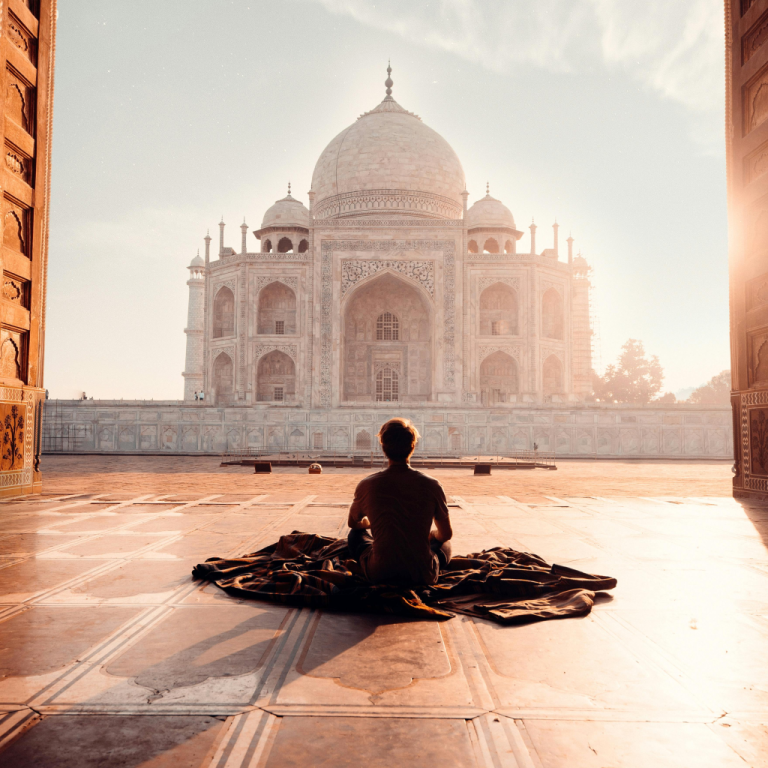The Taj Mahal, an epitome of love and one of the most celebrated structures in the world, stands majestically on the banks of the Yamuna River in Agra, India. This ivory-white marble mausoleum, often referred to as a “teardrop on the cheek of time,” is a UNESCO World Heritage Site and one of the New Seven Wonders of the World. Its story is as enchanting as its beauty, a tale of love immortalized in stone.
A Historical Romance
The Taj Mahal was commissioned by Mughal Emperor Shah Jahan in 1632 in memory of his beloved wife, Mumtaz Mahal, who died during childbirth. Heartbroken by her death, Shah Jahan sought to create a monument that would be as eternal as their love. The construction of the Taj Mahal took approximately 22 years, employing over 20,000 artisans and craftsmen from across India, Persia, Europe, and the Ottoman Empire. The design is attributed to Ustad Ahmad Lahauri, a renowned architect of the time.
Architectural Marvel
The Taj Mahal is an exemplary blend of Islamic, Persian, Ottoman Turkish, and Indian architectural styles. It covers an area of about 42 acres and is part of a larger complex that includes a mosque, a guest house, and extensive gardens. The main mausoleum, built on a raised platform, is flanked by four minarets at each corner, each standing 40 meters tall. These minarets are slightly tilted outward to prevent them from falling onto the tomb in case of an earthquake.
The central dome, rising to a height of 73 meters, is the most striking feature of the Taj Mahal. It is surrounded by four smaller domes and embellished with intricate carvings and precious gemstones. The marble walls are inlaid with semi-precious stones in beautiful floral patterns, a technique known as pietra dura. Verses from the Quran are inscribed in calligraphy throughout the structure, adding to its spiritual and artistic aura.
Gardens and Waterworks
The Taj Mahal is set amidst a charbagh (four-part) garden, symbolizing the Islamic concept of Paradise. The garden is divided by four watercourses, reflecting the Persian garden style. These watercourses converge into a large pool, perfectly reflecting the image of the Taj Mahal. The lush greenery, blooming flowers, and the serene sound of flowing water create a tranquil environment, enhancing the ethereal beauty of the monument.
Symbolism and Legacy
Beyond its architectural splendor, the Taj Mahal is a symbol of eternal love and loss. It represents Shah Jahan’s profound grief and his desire to immortalize his beloved wife. The monument’s white marble, changing hues with the light of the day, is often interpreted as an allegory for the different moods of a woman.
The Taj Mahal continues to inspire artists, poets, and lovers worldwide. Its story and grandeur attract millions of visitors each year, making it one of the most popular tourist destinations globally. It stands as a testament to the rich cultural heritage of India and the enduring power of love.
Visiting the Taj Mahal
When planning a visit to the Taj Mahal, it’s best to go early in the morning or late in the afternoon to avoid the crowds and witness the stunning play of light on the marble. The monument is open from sunrise to sunset, except on Fridays when it is closed for prayers. Special night-time viewings are also available on full moon nights, offering a magical experience as the marble glows under the moonlight.
Preservation Efforts
The Taj Mahal faces several threats, including pollution, environmental degradation, and the sheer number of tourists. Efforts are ongoing to preserve this invaluable piece of heritage. The Indian government, along with various international organizations, has implemented measures to protect and maintain the Taj Mahal, ensuring that it continues to enchant future generations.
Conclusion
The Taj Mahal is more than just a building; it is a masterpiece of art, an architectural wonder, and a symbol of undying love. Its timeless beauty and historical significance make it a must-visit for anyone exploring India. As you walk through its gates and gaze upon its magnificent dome, you can’t help but be moved by the story it tells—a story of love, loss, and the enduring human spirit.






